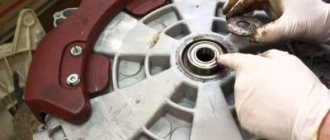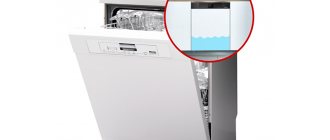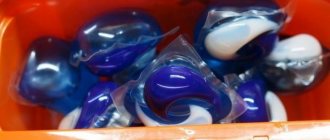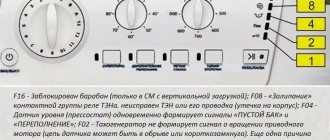There are quite a few PMM models for the kitchen. Moreover, each manufacturer of dishwashing equipment strives to stand out from the rest: some add various sensors to the design of the dishwasher, while others add new units with additional functions.
But, regardless of the brand, the general operating principle of a household-class dishwasher is the same. The main operating units of equipment under different brands are also similar. How does a dishwasher work and on what principle does it work? It is these questions that we will examine in detail in this material. We will also consider basic recommendations for operating dishwashers.
Malfunctions and their elimination
There are many problems that can cause the device to become unstable. If the machine does not start to function, the reason may be the following:
- The water supply tap is closed. If there is no water, the device will not turn on.
- Incorrect hose connection. If the installation was not carried out according to the instructions, there is a possibility that water will not flow in the required quantity.
- There is no water in the water supply system.
- Insufficient water pressure. A similar problem often occurs in country houses that have an autonomous water supply system.
- The inlet hose was bent. Incorrect connection of the device may result in the hose being bent during operation and the throughput being reduced.
- The filter on the inlet hose is clogged. It is designed to remove contaminants.
- The door was not completely closed. If a foreign object gets into the space between the housing and the door, the PMM will not turn on. The device is equipped with a special sensor, which eliminates the possibility of flooding of the room due to poor sealing of the working part.
Most problems can be eliminated on your own, since to do this it is enough to provide the required water pressure and clean the filter element. If the washing procedure is ineffective, you need to pay attention to the following points:
- The container does not contain the required amount of detergent.
- The washing program was selected incorrectly.
- The fine filter is clogged.
There is a possibility of a problem with water drainage. It can be caused by a bent hose, as well as a clogged sewer. A white film may appear on the surface of the dishes if the lid of the special container for storing salt is not tightly closed.
The built-in dishwasher is equipped with a device that can independently detect a malfunction and indicate the corresponding code on the display.
Rules for using a household dishwasher
Tablets, liquids and powders intended for dishwashers contain a minimum of foaming components. The abundance of foam only harms the process of washing dishes in the PMM. The less it is, the better. Therefore, you cannot use regular soap or anything similar in the dishwasher.
When placing dishes in the basket, you should make sure that they do not lie close to each other - this way the spray jets will not be able to hit closed surfaces and will not wash away all food residues
Not all cutlery can be washed in the PMM. Drying with hot air is contraindicated for plastic. The plate from it will at least soften, and maybe “leak” with plastic drops. In the latter case, the machine will most likely fail instantly.
Glasses and cups should be placed upside down in the basket. This will make it easier for streams from the sprinklers to get inside, plus most of the water will flow out of them by gravity.
And most importantly, nothing should interfere with the movement of the blades with nozzles. This will either break the dishes or damage the sprinklers. We provided detailed recommendations for operating a dishwasher in our other article.
If there are remnants of washed-out food left at the bottom of the washing chamber, this indicates a clogged drain filter. It needs to be cleaned regularly. But the fewer large pieces of food left on the dishes, the less often you will have to take it out and wash it, so it’s better not to be lazy in the beginning and carefully remove large leftovers from the plates.
Have you discovered that your dishwasher is clogged? In this case, we recommend that you familiarize yourself with DIY cleaning tips.
How long does it take to wash dishes?
The average washing time ranges from 25 minutes to 2.5 hours. When using pre-soaking and rinsing, the operating time increases by a quarter of an hour.
In addition, if you select a high temperature, it may take longer to wash the dishes.
When determining a suitable option, you need to proceed from the PMM modes. They may vary depending on the brand/model.
Most often, dishwashers have the following modes:
- intensive - for washing very dirty dishes, implies a temperature of 70 degrees and a time of 1 hour;
- normal - in addition to the main wash, drying and rinsing are added;
- economical - 2 hours, copes with common stains;
- fast - 0.5 hours, cleans plates that are not too dirty.
After finishing work, wait a while until the dishes reach room temperature.
What can and cannot be washed
PMM is able to cope with washing any dishes, be it plates of different depths, saucepans, cups, spoons, forks, pans and much more.
But there are a number of products that are prohibited from being placed in the dishwasher.
This category includes:
- steel, wood and glued objects;
- antiques;
- aluminum products that can oxidize;
- crystal (allowed with extreme caution);
- porcelain products with a pattern that is not intended for high temperatures;
- plastic items that do not have appropriate marks;
- dishes with inserts made of copper, wood, tin or mother-of-pearl;
- cast iron cookware;
- kitchen knives (due to the risk of damage to the PMM);
- items with stickers;
- silver items (quickly darken);
- sponges for the kitchen.
At the same time, let’s look at what can be washed in the dishwasher:
- glass, copper, stainless and ceramic dishes;
- Silicone forms;
- juicer;
- cupronickel spoons and forks;
- porcelain products without designs;
- objects made of enameled metal.
Please note that plastic dishes can only be washed if they are reusable and have appropriate marks on the surface.
Some people manage to use PMM for other purposes and wash potatoes and other vegetables in the machine. But with this application you need to be careful not to damage the device.
How to dry in a dishwasher
At the final stage, the dishes are dried, which come in several types:
- Condensation
- Intense.
- Turbocharged.
Let's briefly look at the features of each option.
| Type of drying | Principle of operation | pros | Minuses |
| Condensation | The water evaporates and flows from the inner walls into the pan, after which the pump pumps out the water. | The simplest method. Low price PMM. No heat impact on fragile items. Silence. Minimum electricity consumption. | Long drying time. Presence of divorces. |
| Turbo drying | The heating element heats the air, and the fan directs it to the dishes. | Fast drying speed. No divorces. | The high cost of such models. Increased electrical consumption. Risk of damage to some items that are sensitive to heat. |
| Intensive with heat exchanger | Drying dishes occurs due to the circulation of warm air, but without the use of a cooler. The principle is based on creating a pressure difference in the water collector and the dishwasher chamber. | Slightly lower consumption than in the case of turbo drying. Higher quality than in the situation with the condensing option. Affordable price models. No drips or streaks. | Works slower than "Turbo drying" |
In pursuit of clients, many manufacturers are introducing proprietary types of drying. For example, Electrolux calls this process AirDry.
The bottom line is that after completing each program, the doors open 10 cm to dry the machine using natural ventilation.
As for Siemens and Bosch, these manufacturers have introduced Zeolith Airflow and Zeolith Drying technology.
The first ensures correct flow distribution during drying, and the second converts water into thermal energy. As a result, electricity is saved and the drying process is accelerated.
Dishwasher testing
When a long-awaited device appears in the house, the owner wants to immediately turn it on and check its functionality.
There's no need to rush. First, you should carefully read the instructions so that standard operation of the equipment does not appear to be signs of breakdown.
The only difference between a test run of the machine and a working one is the absence of dishes in the basket. Otherwise, you need to do everything the same: load detergents, salt, rinse aid. It is advisable to check the equipment on the cycle with the highest temperature
The operation of dishwashers from different manufacturers can vary significantly, so appliance manufacturers provide detailed instructions for the first start-up. Do not ignore their recommendations, otherwise you may encounter unexpected problems during operation of the device.
Purpose of checking the dishwasher
Before switching on for the first time, it is mandatory to test the dishwasher - run one cycle without loading dishes.
This check has several purposes:
- Cleaning. After manufacturing at the factory, traces of lubricants and small particles of debris remain inside the parts of new equipment. While the car is in the store, it is inspected and touched with hands, which leads to the appearance of stains. A test run removes dirt and prepares the equipment for use.
- Functionality check. During the first switching on, defects in the manufacturing of the equipment appear. If it was damaged during transportation, this will also become obvious.
- Monitoring correct installation and connection. There is always a place for unfortunate accidents in life. The installers could have made a mistake during installation, connection to the water supply or sewerage system. Sometimes they simply forget to remove the shipping elements. The test will reveal any shortcomings.
- User training. Even if this is not your first dishwasher, you still have to get used to the new equipment. Machines from different manufacturers have their own characteristics, and you need to deal with them before the device is put into operation.
For a test run, you will need a starter kit - detergent, salt and rinse aid. It is either purchased separately specifically for testing the machine, or the one that is planned to be used for washing dishes in the future is used. This will help you decide on the amount of salt and type of detergent.
Already during a test run, you need to do everything the same as when washing dishes: load household chemicals, select a mode. Thanks to these simple steps, you can immediately understand the operating features of the machine.
Sometimes users make the mistake of running the first cycle without detergent, loading only salt. In this way they are trying to save an extra tablet or dose of gel. Do not do this. Hot water will wash away the technical lubricant, but traces of the greasy composition may remain under the rubber bands.
Procedure for idle start
First of all, the dishwasher is carefully inspected. You need to make sure that it is not damaged and that there are no foreign objects in the camera. Sometimes foam sealing inserts, stickers, etc. are forgotten inside the device. If everything is in order, you can turn on the machine and unscrew the valve that shuts off the water.
Salt improves its water quality. It is important to correctly calculate the amount of softener, focusing on its hardness. To do this, use the test strips included in the machine's operating kit.
Then they proceed according to the following scheme:
- Check whether the machine is level.
- All supply and outlet hoses must be securely connected and joints sealed. Make sure of this.
- Open the camera door. You need to check whether the sprayer rotates freely. To do this you need to turn it several times.
- The drain filter is unscrewed, thoroughly washed with running water and household chemicals, and then replaced.
- When selecting detergents, you need to find ones that will not damage machine parts. The required amount of salt and rinse aid is calculated immediately in order to set a program for the future.
- When all the preparatory work is completed, the machine is set to the longest dishwashing mode without loading the basket. It is important that the temperature is as high as possible.
- All that remains is to close the door tightly, start the dishwasher and monitor its operation. If everything is going well, there is no need to interfere and try to improve something.
To prevent the regenerating salt from sticking together while the machine is running, pour about a liter of clean water into the empty compartment.
Only after this procedure can it be filled out. The recommended amount of liquid is 300-500 g.
If the dishwasher is not unplugged, the set parameters (type of chemicals, amount of salt, rinse aid) will remain unchanged. But in the event of a power outage, you will have to enter these data again
If the dishwasher itself does not detect the chemicals, you need to manually enter the type of detergents and salt supply mode into the settings. Modern machines remember the entered parameters.
Aspects requiring attention
While the dishwasher operates in test mode, you need to check the following functions:
- water supply - normally it flows uninterruptedly, the machine does not stop;
- heating - make sure that the heating element is in order; it cannot be checked in a store, so only a test run can reveal problems;
- drain - water should flow out completely and without delay;
- drying – you need to check whether moisture remains in the chamber after the end of the cycle.
If there are no complaints about the functionality of the dishwasher, it can be put into full operation. Do not load dishes once the machine has completed the test cycle. It needs to cool down, so it's best to wait a couple of hours.
Usually a new machine works smoothly and no difficulties arise. If something is in doubt, it is better to look at the instructions again
Sometimes a test run is entrusted to the technician who installed and connected the dishwasher. This makes sense if such equipment has never been in the house or there is cause for concern regarding a specific model. Most often, the concern is unfounded.











